Breathing Easier: China's Bold Plan to Clear the Air in 2024

China is setting an ambitious environmental target to decisively combat severe air pollution, with a comprehensive plan to achieve cleaner skies by the end of 2025. A high-ranking environment official recently announced the government's commitment to dramatically improve air quality through aggressive pollution control and emissions reduction strategies.
This bold initiative, dubbed the "battle for blue skies," represents a significant national effort to address environmental challenges and enhance the quality of life for millions of citizens. The government is intensifying its approach to tackle air pollution, signaling a strong determination to create a more sustainable and healthier urban environment.
By implementing stringent measures and investing in clean technology, China aims to transform its environmental landscape and set a new standard for urban air quality. The goal extends beyond mere reduction, targeting a comprehensive elimination of severe air pollution that has long plagued many of the country's industrial and metropolitan regions.
This strategic environmental push underscores China's growing commitment to sustainable development and demonstrates the nation's proactive stance in addressing critical ecological concerns. As the deadline approaches, citizens and environmental experts alike are watching with anticipation to see how effectively these ambitious targets will be realized.
